
The White House / Flickr
CV NEWS FEED // US Vice President JD Vance and Secretary of State Marco Rubio, accompanied by their wives, Usha Vance and Jeanette Rubio, met with Pope Leo XIV in a private audience May 19, following their attendance of the pontiff’s inaugural Mass the previous day.
According to Vatican News, the meeting underscored the significance of US-Vatican diplomatic ties under the leadership of the first US-born pope.
During the visit, Vance extended a formal invitation from President Trump and First Lady Melania Trump for Pope Leo to visit the White House, Press Secretary Karoline Leavitt confirmed in a briefing Monday. The Pope received the letter graciously, responding with “at some point,” according to Axios. However, no date has been set.
A visit from Pope Leo would be the fourth time a pontiff has visited the White House. Previous papal visits include Pope John Paul II’s meeting with President Jimmy Carter in 1979 and Pope Benedict XVI’s visit with President George W. Bush in 2008.
The encounter also included symbolic gift exchanges: Vance presented the Pope with two works by St. Augustine and a Chicago Bears T-shirt, while the Pope gave a bronze sculpture titled “Peace is a fragile flower.” The visit touched on key topics such as US–Vatican relations, religious freedom, and international humanitarian concerns, including conflicts like the war in Ukraine.
After the audience, Vance held additional discussions with Archbishop Paul Richard Gallagher, the Vatican’s secretary for relations with states and international organizations. The meeting focused on strengthening collaboration between the Holy See and the US, with particular emphasis on religious freedom and the Church’s global mission.
The Holy See Press Office noted that both parties also exchanged views on pressing international issues.
“Finally, there was an exchange of views on some current international issues,” the press office reported, “during which hope was expressed that humanitarian law and international law be respected in areas of conflict and that there be a negotiated solution between the parties involved.”

